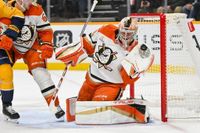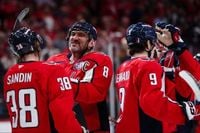The NHL’s 2025-26 season is set to open with a flurry of anticipation, and two teams—each with their own high-stakes narratives—are drawing particular attention: the Detroit Red Wings and the Washington Capitals. Both franchises enter the new campaign with playoff aspirations, but their paths to achieving those dreams couldn’t be more different. From Detroit’s gamble on veteran goaltender John Gibson to Washington’s quest to prove last season wasn’t a fluke, the drama is palpable as training camps wind down and the puck drop looms.
Let’s start in Motown, where the Red Wings’ playoff hopes are riding squarely on the shoulders of their new starting netminder, John Gibson. Detroit’s general manager, Steve Yzerman, made a bold move in the offseason, acquiring Gibson from the Anaheim Ducks in exchange for a 2027 second-round pick, a 2028 fourth-round pick, and goaltender Petr Mrazek. The price was steep, but so too are the expectations: Gibson is now under contract for the next two seasons at an annual salary of $6.4 million, and Yzerman’s own future could be intertwined with the goalie’s success or failure.
At 32, Gibson brings a wealth of experience, having played 506 regular-season NHL games with a career .910 save percentage. Last year in Anaheim, he posted a .912 save percentage and a 2.77 goals-against average, despite appearing in just 29 games due to health concerns. Those numbers are solid, considering the Ducks allowed the most shots against and the second-most expected goals against in the league. According to moneypuck.com, Gibson managed to save 15.3 goals above expected last season, ranking him 13th among NHL goalies—a testament to his ability to steal games even when the odds are stacked against him.
Detroit is banking on Gibson being more than just an upgrade; they need him to be a difference-maker. The Red Wings finished the 2024-25 season just five points shy of a playoff berth, with a 16-8-8 record in one-goal games. Their goaltending wasn’t disastrous, but it wasn’t enough to tip those close contests in their favor. Cam Talbot, last year’s backup, posted a .901 save percentage and a 2.93 goals-against average over 42 appearances, saving 12.8 goals above expected. Mrazek, meanwhile, was a minus-14 between his time in Detroit and Chicago, underscoring why Yzerman felt compelled to make a change.
The Red Wings’ defensive corps, anchored by Moritz Seider and Simon Edvinsson, finished 15th in fewest shots against and 20th in expected goals against last season. While not the worst in the league, the unit doesn’t inspire overwhelming confidence beyond its top two blueliners. That means Gibson will once again be tested nightly—much as he was in Anaheim. The hope in Detroit is that the veteran will thrive under the spotlight, giving the team a chance to turn narrow losses into crucial wins and finally break their nine-year playoff drought.
Yzerman’s gamble is as much about the present as it is about the future. If Gibson can re-establish himself as a top-tier goalie and provide stability in the crease, the Red Wings could find the consistency needed to make a postseason push. But if things go sideways, the consequences could be severe—not just for Gibson, but for the entire front office. The stakes couldn’t be higher. As the goaltender carousel continues to spin across the NHL, Detroit’s bet on Gibson is one of the most compelling stories to watch this season.
Meanwhile, in the nation’s capital, the Washington Capitals are facing a very different kind of pressure—a fight not for relevance, but for validation. Last season, the Capitals stunned the hockey world by finishing with 111 points, the most of any Eastern Conference team. It was a campaign marked by depth, resilience, and a touch of magic. Yet, as the new season dawns, the question on everyone’s mind is simple: can they do it again?
Washington’s roster remains largely unchanged, and the team is hoping to build on the foundation laid in 2024-25. The storylines abound, starting with Alex Ovechkin’s historic year. The legendary winger scored 44 goals, breaking the NHL’s all-time goal record just months after suffering a broken leg. Ovechkin’s shooting percentage of 18.6% was the highest of his storied career, and his production was a huge part of the Capitals’ 13 goals above expected at five-on-five play. While fans would love a repeat, expecting a 40-year-old to maintain that level of efficiency is a tall order.
Supporting Ovechkin were Pierre-Luc Dubois and Tom Wilson, who delivered standout two-way performances. When on the ice together, the Capitals controlled 55 percent of expected goals and outscored opponents 42-29. Aliaksei Protas emerged as a revelation, morphing from a depth forward into a 30-goal scorer and providing much-needed secondary scoring. The Capitals’ strength, however, lies in their balance and defensive depth. Six defensemen—all above-average puck-movers—helped Washington achieve an 82.5 percent successful exit rate, second only to the Carolina Hurricanes last year. John Carlson and Jakob Chychrun anchor the blue line, while Rasmus Sandin’s breakout season added another layer of reliability.
Between the pipes, Logan Thompson’s first season as Washington’s starter was a tale of two halves. From November to January, he was nearly unbeatable, posting a .935 save percentage and saving 30 goals above expected. That form earned him a six-year, $35.1 million contract, but an upper-body injury derailed his momentum, and his numbers dipped late in the season. Still, Thompson finished with 25 goals saved above expected in 43 games and was stellar in the postseason, saving 8.5 goals above expected in 10 playoff games. Backup Charlie Lindgren offers a strong safety net, having saved 24 goals above expected over the past two seasons.
Rookie Ryan Leonard is another wild card for the Capitals. After a brief but eventful stint last spring, Leonard is expected to bring energy and scoring touch to the lineup, even if only in a third-line role to start. His development could add a new dimension to an already deep forward group.
Despite all the positives, Washington’s critics point to a lack of true elite talent at the top of the lineup. While Dubois, Wilson, Protas, and Ovechkin all performed at contender-worthy levels last year, the sustainability of those performances is uncertain. Age, short track records, and high on-ice percentages suggest some regression is possible. The Capitals’ depth and defensive prowess should keep them competitive, but whether they can replicate last season’s magic remains the million-dollar question.
As the 2025-26 NHL season gets underway, all eyes will be on Detroit and Washington—two teams with everything to prove and little margin for error. Will Gibson’s arrival in Detroit finally end the Red Wings’ playoff drought? Can Ovechkin and the Capitals silence the doubters and remain atop the Eastern Conference? The answers will unfold on the ice, one save and one goal at a time.

